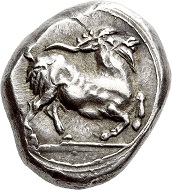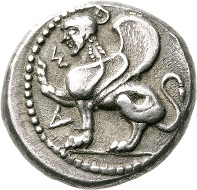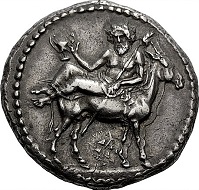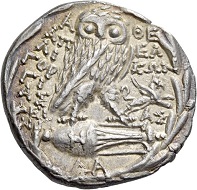by Alan Walker
March 29, 2018 – Let’s talk about a subject that really is important to all those involved with ancient coins: where do they come from?
What may well be obvious to all of you, or, at least, ought to be, is that all the ancient coins we have today, whether in museums, private or public collections, or in commercial hands, ultimately must have come out of the ground (or from under water: from springs, rivers, lakes or the sea). The idea that any coins could have survived above ground since ancient times, while undoubtedly romantic, is more than just highly unlikely! Of course, the Comte du Chastel did maintain that the gold multiple of three solidi minted by Valentinian I (du Chastel 814) that was in his collection was truly in family hands since the time it was minted! He stated that the family arms were those of the city of Valenciennes, supposedly either founded or re-founded by Valentinian. In fact, the first known mention of the town apparently dates to 639 and is found in a document of the Merovingian ruler Clovis II (639-657)… se non è vero, è ben trovato!
Nomos 6, 2012, 81. Paros, from the Paros Hoard of 1936 (IGCH 13). Est. 7,500 / Hammer 25,000 CHF.
In fact, ancient coins come from three basic sources: 1) hoards, 2) deposits, and, 3) losses. Let’s see what they are.
1) Hoards
First things first, the word we are using here, ‘hoard’ (meaning a group of coins or objects), is very much not the same as the word ‘horde’ (which refers to large groups of people or animals); these two words should never be confused. In a narrowly numismatic sense, hoards are defined as groups of coins that have been consciously hidden with the intent of being recovered (on a short, medium or long term basis). As such, hoards fall into four basic groups: a) savings hoards, b) current expenses hoards, c) emergency hoards, and, finally, d) mixed or bullion hoards.
Nomos 6, 2012, 35. Samothrace, from the Kiourpet Hoard of 1930 (IGCH 696). Est 50,000 / Hammer 100,000 CHF.
a) Savings hoards
Saving hoards exist for the simple reason that most individuals in the ancient world had no access to permanent secure storage for their money, in comparison to the banks we have in modern times. For example, a landowner might keep a certain amount of his income readily available to pay for current or daily needs, while the extra would be kept for future use or as savings. This extra money could be poured into a large container and then buried; it could subsequently be reopened to receive further ‘deposits’. This could go on over many years, even generations. In most cases, the coins selected for savings hoards are of the best quality the owner can find: they tend to all be of the same metal (gold or silver or bronze), though mixed hoards are known; depending on the original owner’s financial status, savings hoards tend to be composed entirely of higher denomination coins, usually unmixed (you can have hoards of staters or tetradrachms or drachms or fractions or bronzes); damaged, debased, worn, or underweight coins are consciously avoided in savings hoards. Such hoards can be found in the ruins of ancient buildings, but they can also often be found in isolated locations that were somehow easily identified in ancient times (for example, a hoarder may have selected a location near a landmark that was then locally prominent, such as a distinctive tree, that subsequently disappeared).
Nomos 7, 2013, 39. Mende, from the Kaliandra Hoard of 1913 (IGCH 358). Est. 35,000 / Hammer 40,000 CHF.
b) Current Expenses Hoards
Current Expenses Hoards are groups of coins that were kept for daily use, rather than for long term savings. For example, someone might have kept his or her real assets in a savings hoard, which would have been rather inconvenient of access, while a selection of money might be hidden more conveniently to pay for things on a daily basis. Hoards like this, which can include coins in mixed metals, silver and bronze being the most common, are the kind of hoards that can be found in the ruins of a city that suffered a sudden attack (see below). One peculiarity of current expenses hoards is that they are apt to contain coins of lower quality than those found in savings hoards: debased or light weight pieces (clipped, damaged, etc.), or coins that are in some way less desirable, can turn up in these hoards because their owners want to use and get rid of them!
Nomos 14, 2017, 115. Athens, from the Poggio Picenze Hoard of 1954 (IGCH 2056). Est. 750 / Hammer 1,800 CHF.
c) Emergency Hoards
Emergency Hoards are those hidden in the face of imminent danger. They can be distinguished, though not easily, from other hoards by their content, by the way they are hidden, and, in retrospect, by the evidence of destruction in the area where they were hidden. A hoard buried in fear of attack is likely to have a more ‘omnivorous’ character rather than a selective one. Mixed hoards, those containing coins of all metals and often including inferior pieces, are often a sign of hurried assembly and hiding, rather than of a calm process of selection. Obviously, if the enemy is at the door valuables will be just tossed willy-nilly into a sack and hidden; speed is of the essence. This also means that the container chosen may be of a less permanent type (like a sack, for example) rather than a pot or a chest: the hoarder will just use whatever is to hand and will also probably be hopeful that he or she can recover the treasure as soon as the danger passes. Another form of emergency hoard would be a military unit’s pay chest hidden prior to going into battle, or at the time of an attack: hoards buried by Varus’ s three legions during their losing battle with Arminius’s German army fall into this class of find. Perfect examples of emergency hoards were those found on the floors of the South House in the Athenian Agora (B 17:1), which was destroyed in 267 during the Herulian sack of Athens.
Nomos 14, 2017, 409. Maximinus I, from the Nis Hoard of the early 1930s. Est. 250 / Hammer 480 CHF.
It should be clear that both savings and emergency hoards can vary in size, from very small numbers of coins buried by a simple individual, to gigantic hoards buried by officials or very high ranking people. Two of the very biggest I know of are the Brescello Hoard of 1714, which was buried c. 38 BC, and contained approximately 80,000 (!) Roman gold aurei (the vast majority were melted and turned into ducati by the Este rulers of Modena); and the great Nis hoard of the early 1930s, which reputedly contained something like 15 metric tons (!!) of Roman silver coins (approximately 5 million denarii)! Both of these must have been buried in the face of some imminent peril by their official custodians (who presumably were killed before being able to report where the hoards had been concealed).
d) Mixed or Bullion Hoards
Mixed or Bullion Hoards. I almost forgot about these. Almost invariably composed of silver, the coins found within these hoards were not hoarded primarily as coins, but as bullion. A perfect example is a hoard that I was shown in the early 1990s that had been found in the neighborhood of Crotone in Bruttium. There were about 100 silver coins, primarily 5th century BC issues from Akragas, Gela, Velia, Kroton, Metapontum, etc., and primarily didrachms or staters. With the exception of a few pieces, the latest being a remarkable stater from Olympia (Seltman 295 = Leu 77, 2000, 221), the coins were all very worn, with some of the pieces from Akragas and Gela being practically illegible. It was a rather strange group as is, but it began to make sense when I was shown a bag of unfinished silver jewelry, mostly fibulae (they were mostly as cast, rough, untrimmed and without any incised decoration – a few were partially finished), which had been found with the coins. The total weight of the jewelry was rather more than that of the coins. I recorded the hoard as best I could under the circumstances and when I sent the information off to a scholar friend of mine he told me something fascinating. What I had seen was not a coin hoard per se, but a hoard of the raw material needed for the manufacture of an ancient jewelry! He told me that a number of such hoards were known, but usually only incidentally, because after having been found, the coins would be sold via the coin trade, but jewelry would go to antiquity dealers; thus, no one realized that they had been found together. In addition, the presence of often large and heavy silver ingots of varying shape (including some that clearly showed partially melted coins on their surfaces), combined with coins in a number of other hoards (especially from Egypt, Mesopotamia and further East) showed that they also were actually thought of by their ancient owners as beings hoards of silver bullion rather than of coined money. The fact that many Greek silver coins in Eastern finds dating to the 6th, 5th and early 4th century BC are defaced by chisel cuts also shows that the coins were viewed as bullion that had to be solid silver rather than as coins, which had a face value.
The next part of this little series is dedicated to deposits.
We are sure that everybody knows who Alan Walker is, nevertheless, for those who don’t or who have forgotten, here’s the link to our numismatic Who’s who.
You can find the contact details of Alan Walker on the Nomos website.
More articles on treasure finds are available in our respective archive section.










